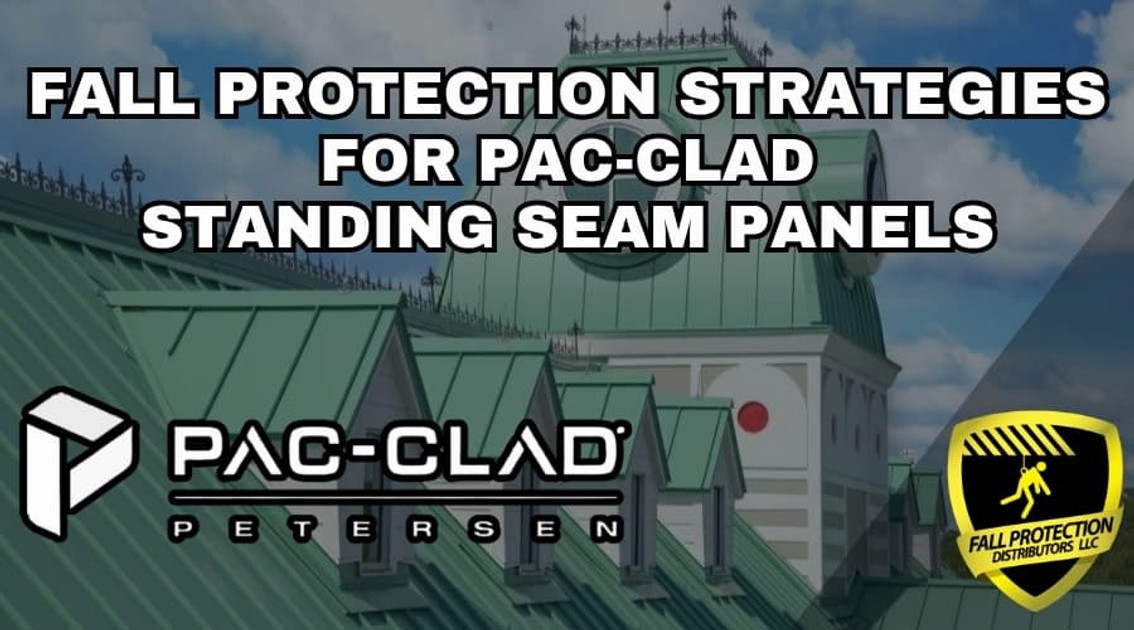Fall Protection Strategies For PAC-Clad Standing Seam Panels
Posted by Howie Scarboro - CEO Fall Protection Distributors, LLC on Nov 14th 2025
See the Roof Anchor Compatibility Chart for Pac-Clad Petersen Standing Seam Panels.

Who Is Pac-Clad Petersen?
Pac-Clad Petersen supplies architectural metal panels trusted across commercial, institutional, and residential construction.
Petersen Aluminum Corporation began in 1965 as a regional metal service center that supported architects and builders who needed consistent coil and sheet products for architectural work. The company built its reputation on dependable lead times and technical service. The Pac-Clad brand grew into a national name within the standing seam roof community, leading to multiple US production locations and strong regional sales support.
Carlisle Construction Materials purchased Petersen Aluminum in 2018, which expanded Pac-Clad's reach, testing capabilities, and long-term product development resources. Today, their products appear on commercial buildings, institutional campuses, industrial facilities, and custom residential projects where visual detail and long service life carry equal weight. The lineup includes multiple standing-seam profiles, along with architectural wall and trim solutions, which means installers and maintenance teams encounter a wide range of slopes, gauges, and attachment styles when working with Pac-Clad roofs.

What Are The Most Compatible Fall Protection Products For Pac-Clad Standing Seam Roofs?
Non-penetrating anchors protect panel integrity and warranty compliance while supporting safe fall protection anchoring.
Pac-Clad standing seam systems do not allow penetrations for temporary or permanent fall arrest tie-offs. Holes, screws, and panel penetrations can void warranties, invite unwanted water leaks, and cause oil-canning(visual distortions/waves) of the panels. We discuss two potential solutions in this blog. The first solution is seam-mounted anchors that attach directly to the standing seams using non-penetrating set screws. The second option is ridge-based anchors that secure at the roof peak without relying on the seam attachment.
For non-curved 22-gauge and 24-gauge steel panels, the complete SSRA system offers temporary tie-off, walkboard staging, and horizontal lifelines without penetrating the metal. The SSRA1 Standing Seam Roof Anchor attaches to the seam with stainless-steel set screws at low torque. The SSRA2 Adjustable Roof Jack Adapters mount to two SSRA1 anchors to support ten-foot walkboards, reducing fatigue and providing installers with a level work surface on steep metal roofs.
The SSRA3 Anchor Plate mounts on two SSRA1 anchors to support temporary lifelines. This assembly is part of the SSRA HLL 100-foot Temporary Horizontal Lifeline Kit for two-worker movement. Long-term maintenance teams may choose the Super Anchor 120-foot Permanent Horizontal Lifeline Kit when routine roof access is necessary.
For aluminum, copper, and lighter-gauge steel, the recommended method is a ridge-based system, such as the Ridge Pro Steep Assist Anchor, on slopes from 6:12 to 12:12. This approach keeps the attachment at the ridge, where no seam contact occurs. Workers connect to a vertical lifeline while still on the ladder, step onto the roof with a secure tie-off already in place, and complete work without relying on seam attachment.
A qualified fall protection specialist should inspect panels that taper, radius, or curve to determine the most suitable safety equipment for the crew. Have safety managers test-fit seam anchors before the workday to verify proper fitment on the seam profile.
Snap-Clad Snaplock Panels
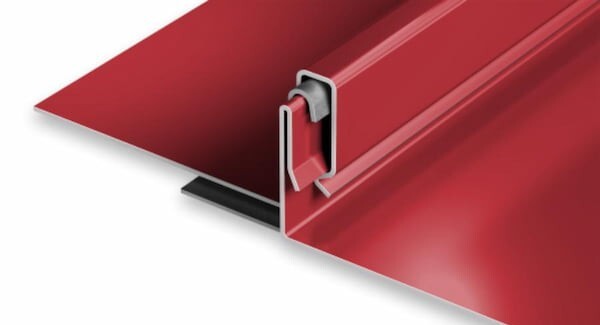
Snap-Clad panels use a 1.75-inch snaplock seam with wide size and substrate options.
Snap-Clad snaplock roofing panels feature a 1.75-inch seam that enhances wind performance and provides a clean architectural appearance. These panels install over solid wood or metal decking with a recommended minimum slope of 2:12. Available panel widths are 10, 12, 16, and 18 inches, with panels available in 22-gauge steel, 24-gauge steel, and .032 or .040 aluminum. This mix gives builders and designers flexibility for commercial, residential, and institutional projects that need a reliable snaplock system without field-seamed mechanical closure. See the Roof Anchor Compatibility Chart for Pac-Clad Petersen Snap-Clad Standing Seam Panels.
Fall Protection For Snap-Clad Panels
Steel Snap-Clad panels support seam-mounted anchors; however, aluminum versions require ridge-based tie-off solutions.
Straight, non-curved Snap-Clad panels in 22-gauge or 24-gauge steel are compatible with the SSRA1 seam-mounted anchoring system. The SSRA1 Standing Seam Roof Anchor attaches directly to the panel seam using twelve non-penetrating stainless-steel set screws that hold securely without damaging the metal. When workers need a stable platform for staging and detail work, the SSRA2 Adjustable Roof Jack Adapters mount on two SSRA1 anchors to support a 10-foot walkboard and create a safe work surface on steep metal roofs.
The SSRA3 Anchor Plate mounts on two SSRA1 anchors. It serves as an endpoint connection for the SSRA HLL 100-foot Temporary Horizontal Lifeline Kit, which supports two-worker mobility on larger work areas. Long-term maintenance plans may include the Super Anchor 120-foot Permanent Horizontal Lifeline Kit for buildings that receive routine rooftop service.
SSRA anchors require a minimum of 24-gauge steel, so they are compatible with 22-gauge and 24-gauge Snap-Clad steel. Aluminum Snap-Clad panels do not support seam-mounted anchoring, making the Ridge Pro Steep Assist Anchor the recommended method for 6:12 to 12:12 slopes. Ridge attachment avoids seam attachment and keeps the worker connected before stepping onto the surface.
A qualified fall protection expert must inspect curved or tapered roof systems before determining which equipment to use on the job. Complete a test fit before the workday begins to confirm anchor compatibility with standing seam roofs.
Tite-Loc and Tite-Loc Plus Mechanical Lock Panels

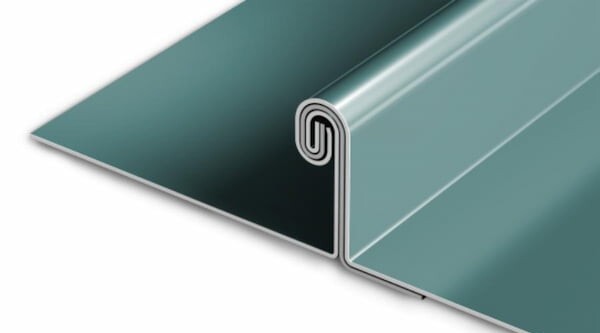
A mechanically-seamed system built for low-slope performance and architectural flexibility.
Tite-Loc and Tite-Loc Plus panels use mechanical field-seaming that locks to 90 degrees on the standard version or 180 degrees on the Plus model. This seam-locking method provides a tight weather seal, especially in areas with standing water risks or snow movement. The panels can be installed on slopes down to 1/2:12, making them suitable for long-run commercial roofs, schools, civic buildings, and low-pitch residential designs that require controlled water management rather than fast runoff. See the Roof Anchor Compatibility Chart for Pac-Clad Petersen Tite-Loc and Tite-Loc Plus Standing Seam Panels.
Standard widths include 12, 16, and 18 inches, and buyers can choose from 22-gauge or 24-gauge steel, as well as .032- and .040 aluminum. The 2-inch seam height adds visual depth while providing flexibility, as these panels can be curved when the project calls for architectural shaping rather than straight runs.
Fall Protection For Tite-Loc and Tite-Loc Plus Panels
Seam-mounted anchors are for steel Tite-Loc panels only, while ridge-based systems are the safe option for aluminum installations.
Curved panel installations require special consideration by a qualified fall-protection professional. The following recommendations apply only to straight, non-curved Tite-Loc and Tite-Loc Plus roof systems.
For 22-gauge or 24-gauge steel panels, the SSRA1 Standing Seam Roof Anchor connects directly to the panel seam using twelve non-penetrating stainless-steel set screws that form a reliable attachment point without breaching the metal. The SSRA2 Adjustable Roof Jack Adapters mount to two SSRA1 anchors and support a 10-foot walkboard, providing a stable platform for crews working on steep metal roof areas.
The SSRA3 Anchor Plate pairs with two SSRA1 anchors and functions as the endpoint connection for the SSRA HLL 100-foot Temporary Horizontal Lifeline Kit, allowing two workers to move the length of the roof while remaining tied off. Roofs requiring routine worker access can use the Super Anchor 120-foot Permanent Horizontal Lifeline Kit.
Tite-Loc and Tite-Loc Plus aluminum panels do not support seam-mounted anchoring, so the safe method is ridge-based attachment. The Ridge Pro Steep Assist Anchor allows workers to connect before stepping onto the panel surface. The Ridge Pro works on slopes from 6:12 to 12:12, providing controlled access for steep-slope aluminum installations where preservation of panel integrity is critical.
Any seam-mounted system should be test-fit before the day of work so that the installer can verify that the selected anchor matches the exact Tite-Loc profile.
Snap-On Batten Standing Seam Panels
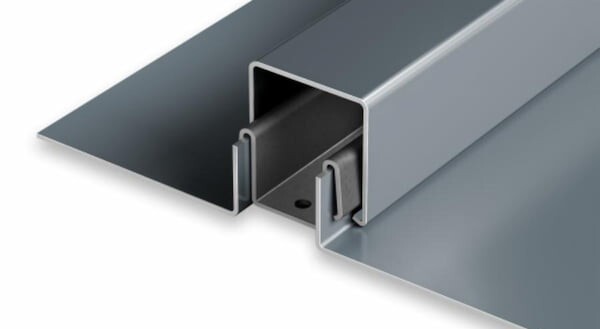
The Pac-Clad Snap-On Batten panel features clean architectural lines and concealed fasteners.
This profile uses a 1.5-inch seam height and requires installation over a waterproof solid deck with a minimum slope of 3:12. Architects often specify this style when they want a classic board-and-batten look without exposed screws. See the Roof Anchor Compatibility Chart for Pac-Clad Petersen Snap-On Batten Standing Seam Panels.
Available panel widths include 12, 16, 18, and 20 inches, and material options include 24-gauge steel and .032 aluminum. Some projects may include curved or tapered versions of this panel.
Fall Protection For Snap-On Batten Panels
Pac-Clad Batten panels do not support seam-mounted anchoring and require ridge-based tie-off planning.
The batten cover is not a structural attachment point, so it is not compatible with SSRA products.
Seam-mounted anchors rely on a direct connection to the panel, but the Snap-On Batten design does not provide that access. For the same reason, the SSRA HLL 100-foot Temporary Horizontal Lifeline Kit and the Super Anchor 120-foot Permanent Horizontal Lifeline Kit are not compatible with this system because each requires SSRA anchors as the connection platform.
Any roof that includes curved or radius-formed Snap-On panels should be evaluated on-site by a qualified fall-protection professional to determine the most suitable fall protection strategies to deploy. The following recommendation applies only to straight, non-curved installations.
For safe access, crews who work on Snap-On Batten roofs can use the Ridge Pro Steep Assist Anchor on slopes between 6:12 and 12:12. The Ridge Pro positions the connection point at the ridge instead of the seam, eliminating the risk of batten cover displacement and preserving roof integrity while giving the worker a secure tie-off point before stepping onto the roof. Order and test-fit seam anchors before the project begins to ensure they attach correctly to the standing seam panels.
Snap-On Standing Seam Batten Panels
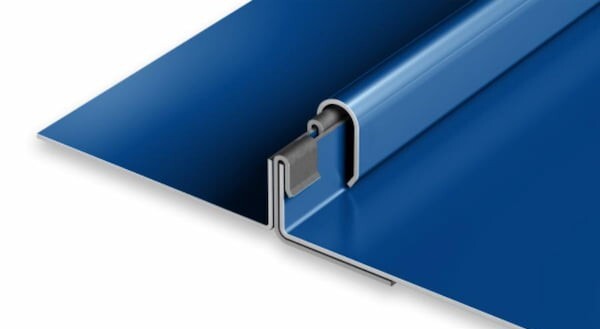
The Snap-On Standing Seam panel features a 1-inch batten height, altering the overall roof shadow line and profile expression.
This panel mounts over a waterproof solid deck using concealed clips and fasteners, preserving a clean architectural finish and helping protect against moisture intrusion. Panel width options include 12, 16, 18, and 20 inches, allowing designers to fine-tune panel proportions on larger roof planes or narrow architectural elements. Material availability includes 24-gauge steel and .032 aluminum, and curving is available when the project requires shaped or radius elements, handled by qualified fabrication personnel. See the Roof Anchor Compatibility Chart for Pac-Clad Petersen Snap-On Standing Seam Batten Standing Seam Panels.
Fall Protection For Snap-On Standing Seam Batten Panels
Batten seams are not compatible with seam-mounted anchors and require ridge anchors for fall protection.
A Snap-On Standing Seam Batten panel prevents the anchor's set screws from making direct contact with the structural seam. For that reason, seam-mounted systems such as SSRA1, SSRA2, and SSRA3 are not compatible with this profile. Since both the SSRA HLL 100-foot Temporary Horizontal Lifeline Kit and the Super Anchor 120-foot Permanent Horizontal Lifeline Kit require SSRA mounting points, they also remain incompatible with High Snap-On Batten roofs.
If the roof includes curved or radius-formed panels, a qualified fall-protection specialist should examine the structure to determine the best fall protection strategy to protect the roof and workers. The following guidance applies only to straight, non-curved Snap-On Standing Seam roof systems.
For safe tie-off access, workers can use the Ridge Pro Steep Assist Anchor on slopes from 6:12 to 12:12. Ridge placement supports the anchor in the event of a worker falling. It provides a secure tie-off point before the worker even steps onto the metal roof. Get the seam anchors on site early, test-fit them, and confirm they match the exact standing seam panel before the workday starts.
High Snap-On Standing Seam Batten-Cover Panels

The High Snap-On Standing Seam panel follows the same batten cover concept as the standard Snap-On system. Still, it features a taller 1.5-inch batten height, altering the overall roof shadow line and profile expression.
This panel mounts over a waterproof solid deck using concealed clips and fasteners, preserving a clean architectural finish and helping protect against moisture intrusion. Panel width options include 11, 12, 16, and 18 inches, allowing designers to fine-tune panel proportions on larger roof planes or narrow architectural elements. Panel materials include 22- and 24-gauge steel and .032 aluminum, with curving available as an option. See the Roof Anchor Compatibility Chart for Pac-Clad Petersen High Snap-On Standing Seam Panels.
Fall Protection For High Snap-On Standing Seam Panels
A High Snap-On Standing Seam panel requires the use of ridge anchors for fall protection.
The batten cap sits over the structural portion of the seam, preventing the set screws from properly locking onto it. For that reason, seam-mounted systems such as SSRA1, SSRA2, and SSRA3 are not compatible with this profile. Since both the SSRA HLL 100-foot Temporary Horizontal Lifeline Kit and the Super Anchor 120-foot Permanent Horizontal Lifeline Kit require SSRA mounting points, they also remain incompatible with High Snap-On Standing Seam panels.
If the roof includes curved or radius-formed panels, a qualified fall-protection specialist should examine the structure in person to determine how to protect the workers and the roof system during roof projects. The following guidance applies only to straight, non-curved High Snap-On installations.
For safe tie-off access, workers can use the Ridge Pro Steep Assist Anchor on slopes from 6:12 to 12:12. Ridge placement keeps anchoring forces off the batten cover. It provides a secure tie-off point before stepping onto the metal roof panels. A test-fit should be planned before the day of work to confirm proper seam compatibility.
Redi-Roof Snaplock Panels

The Redi-Roof standard panel widths are 12, 16, and 18 inches, and seam heights vary by striation style, ranging from 1-3/8 inch to 1-9/16 inch.
Workers should install this panel style over solid decking with a minimum pitch of 3:12. Redi-Roof is available in 22-gauge steel, 24-gauge steel, and .032 aluminum, making it suitable for visually driven commercial, civic, and residential roof projects. See the Roof Anchor Compatibility Chart for Pac-Clad Petersen Redi-Roof Standing Seam Panels.
Fall Protection For Redi-Roof Snaplock Panels
Steel Redi-Roof panels support SSRA anchoring, and aluminum versions require ridge-based tie-off.
22- and 24-gauge steel Redi-Roof systems compatible with SSRA seam-mounted anchoring. The SSRA1 Standing Seam Roof Anchor attaches directly to the seam using twelve non-penetrating stainless-steel set screws that secure without puncturing the metal. For level working surfaces on steeper roof sections, the SSRA2 Adjustable Roof Jack Adapters mount to two SSRA1 anchors to support a 10-foot walkboard.
The SSRA3 Anchor Plate mounts on two SSRA1 anchors. It provides the fixed anchor point for the SSRA HLL 100-foot Temporary Horizontal Lifeline Kit, which supports two-worker tie-off across larger roof areas. Building owners who require routine rooftop access may select the Super Anchor 120-foot Permanent Horizontal Lifeline Kit as part of a long-term maintenance plan. The initial investment is offset by reduced future labor required for temporary fall protection anchor installations.
Redi-Roof panels formed from .032 aluminum do not support seam-mounted anchoring. For aluminum panels, the proper method is ridge-based fall protection using the Ridge Pro Steep Assist Anchor on a 6:12 to 12:12 slope, so workers can connect to their vertical lifeline before even stepping off the ladder and onto the roof surface.
Curved, tapered, or radius-formed layouts require evaluation by a qualified fall-protection professional. All seam-mounted hardware should be test-fit before the day of work to verify proper engagement with the exact Redi-Roof seam.
PAC 150-90 Single Lock and PAC 150-180 Double Lock Mechanical Panels
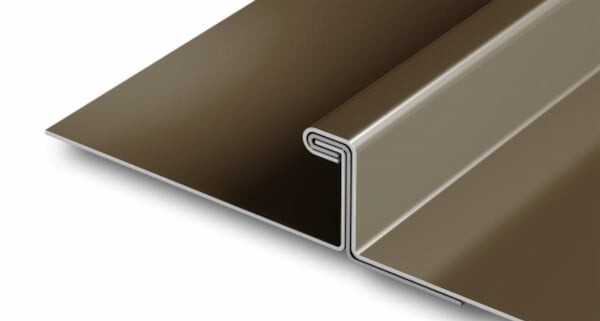

A mechanically seamed low-slope roofing system built for long runs, weather control, and architectural flexibility.
The PAC 150 series is a mechanically locked standing seam system with a 1.5-inch seam height that can be field-seamed to either a 90-degree single lock or a 180-degree double lock, depending on project design, weather exposure, and local requirements. This platform performs well on shallow-pitch applications down to a 1:12 slope. Standard panel widths include 12, 16, 18, and 20 inches, and buyers may choose 24-gauge steel or .032 aluminum. Curving is also available for architectural projects. See the Roof Anchor Compatibility Chart for Pac-Clad Petersen Redi-Roof Standing Seam Panels.
Fall Protection For PAC 150-90 Single Lock and PAC 150-180 Double Lock Panels
Steel PAC 150 panels support SSRA seam anchors, while aluminum versions require ridge-based anchors.
Curved PAC 150 roofs require on-site evaluation by a trained safety expert to determine the most suitable fall protection equipment for the workers. The following guidance applies only to straight, non-curved PAC 150 installations.
For 24-gauge steel PAC 150 panels, workers may use the SSRA seam-mounted anchoring system. The SSRA1 Standing Seam Roof Anchor attaches directly to the seam using twelve non-penetrating stainless-steel set screws that secure without piercing the metal seams. When walkboards are needed for steeper roof areas, the SSRA2 Adjustable Roof Jack Adapters mount to two SSRA1 anchors and support a 10-foot walkboard, providing a level walking surface on slopes that demand sure footing.
For maximum worker mobility, the SSRA3 Anchor Plate mounts to two SSRA1 anchors. This assembly serves as the anchor point for the SSRA HLL 100-foot Temporary Horizontal Lifeline Kit, which supports two workers on larger roof areas. Building owners who want a permanent fall protection system may consider the Super Anchor 120-foot Horizontal Lifeline Kit to protect workers on roofs that require routine maintenance.
PAC 150 panels manufactured from .032 aluminum are not compatible with SSRA fall protection products. For aluminum panels, ridge-based anchorage is the best method with the Ridge Pro Steep Assist for slopes between 6:12 and 12:12, so workers can connect to a secured vertical lifeline before stepping onto the metal panels.
All projects should include a test-fit before the day of work to verify seam compatibility.
PAC T-250 Structural Panels
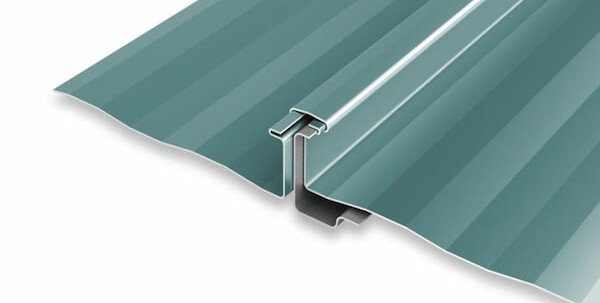
The PAC T-250 panel is a structural standing seam profile with a 2-5/8-inch tall seam that performs well on large buildings where long roof runs and controlled water drainage are critical.
This system can be installed on roof slopes as low as 1/2:12, making it suitable for aviation hangars, civic buildings, industrial campuses, and long-span commercial roofs. Available panel widths are 16 and 18 inches, with panel material options in 22-gauge steel, 24-gauge steel, and .032- or .040 aluminum. The tall seam height helps maintain water movement even in slow-draining conditions, making the T-250 one of the most capable low-slope profiles in the Pac-Clad lineup. See the Roof Anchor Compatibility Chart for Pac-Clad Petersen PAC T-250 Standing Seam Panels.
Fall Protection For PAC T-250 Panels
Steel T-250 panels accept SSRA anchoring, and aluminum installations require ridge-based tie-off solutions.
Any curved or radius-formed T-250 installation should be reviewed by a qualified fall-protection professional since seam alignment, clip pressure, and load transfer do not behave the same once the panel is bent. The following recommendations apply only to straight, non-curved T-250 installations.
When the T-250 profile is 22-gauge or 24-gauge steel, it supports seam-mounted anchoring. Workers can use the SSRA1 Standing Seam Roof Anchor, which attaches directly to the seam using twelve non-penetrating stainless-steel set screws to create a secure tie-off point without breaching the metal. Workers can use SSRA2 Adjustable Roof Jack Adapters with SSRA1 anchors whenever walkboards are needed on steep metal roofs. This assembly provides a safe level work platform that adapts to various seam heights and roof pitches.
For horizontal mobility, the SSRA3 Anchor Plate attaches to two SSRA1 anchors. It forms the endpoint interface for the SSRA HLL 100-foot Temporary Horizontal Lifeline Kit, which supports two-worker movement. Buildings that require repeat rooftop access may include the Super Anchor 120-foot Permanent Horizontal Lifeline Kit for long-term service planning.
When the PAC T-250 system is .032 or .040 aluminum, seam-mounted anchoring is not allowed. In those cases, crews can use the Ridge Pro Steep Assist Anchor on slopes from 6:12 to 12:12. This will enable them to connect while still at the access point, rather than stepping onto unprotected metal.
All anchoring equipment should be test-fit before the day of work to verify proper engagement with the exact T-250 seam shape, finish, and substrate.
Standing Seam Metal Roof Anchor Panel Compatibility Chart For Pac-Clad Petersen
| Snap-Clad 24 Ga. | Snap-Clad 22 Ga. | Tite-Loc 24 Ga. | Tite-Loc 22 Ga. | Redi-Roof 24 Ga. | Redi-Roof 22 Ga. | PAC T-250 24 Ga. | PAC T-250 22 Ga. | |
|---|---|---|---|---|---|---|---|---|
SSRA 1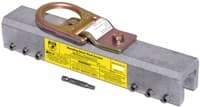 |
NO | YES | NO | YES | NO | YES | NO | YES |
SSRA1 Nylon Tip |
YES | YES | YES | YES | YES | YES | YES | YES |
SSRA2 Roof Jack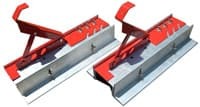 |
YES | YES | YES | YES | YES | YES | YES | YES |
SSRA3 Anchor Plate |
YES | YES | YES | YES | YES | YES | YES | YES |
The Ridge Pro |
YES | YES | YES | YES | YES | YES | YES | YES |
Standing Seam Metal Roof Anchor Panel Compatibility Chart For Pac-Clad Petersen
| Snap-On Batten | Snap-On Standing Seam Batten | High Snap-On | PAC 150-90 | 150-180 24 Ga. | |
|---|---|---|---|---|
SSRA 1 |
NO | NO | NO | NO |
SSRA1 Nylon Tip |
NO | NO | NO | YES |
SSRA2 Roof Jack |
NO | NO | NO | YES |
SSRA3 Anchor Plate |
NO | NO | NO | YES |
The Ridge Pro |
YES | YES | YES | YES |
Contact Us for Expert Standing Seam Fall Protection Advice
For expert guidance on standing seam roof anchors, lifeline kits, and fall protection systems that protect both your crew and your panels, contact us today at 863-703-4522 or visit www.StandingSeamRoofAnchor.com. Our safety specialists can help you match the right non-penetrating anchor to your specific roof profile and slope. Let's make your next metal roofing project safe, compliant, and built to last. For continued learning, download OSHA's 48-page Fall Protection Manual and our free Anchor Inspection Form once you've selected the ideal anchors for your roof system. Together, we'll help you stay ahead of OSHA standards while preserving your roof's weather-tight seal.
Safety Tips For Standing Seam Roofs
Equip Workers with High-Quality Safety Gear
OSHA fall protection begins with workers wearing gear that fits properly, passes inspection, and suits the job they are performing. Harnesses, connectors, and SRLs should be checked for wear before anyone steps onto the roof.
Use Anchor Systems Built for Standing Seam Roofs
Standing seam roof systems use hidden fasteners to avoid water leaks, so anchor points must connect without penetrations. Non-penetrating anchors, such as the SSRA1, attach directly to approved steel seams using stainless-steel set screws.
Install Permanent Roof Anchor Systems
Routine service access is common in commercial buildings, and OSHA permits permanent fall protection systems when they are installed and inspected correctly. A system such as the Super Anchor 120-foot Permanent Horizontal Lifeline Kit can reduce the need for repeated temporary hardware installation and provide a known safe access point for future maintenance personnel.
Prioritize Ladder Safety Training
Falls often happen during the climb rather than while working on the roof. Regular ladder reminders regarding correct 4-to-1 angle, three points of contact, and stable ground placement help prevent access-related injuries. A few minutes of refresher training before setup reduces rushed decisions that lead to preventable accidents.
Develop OSHA-Compliant Safety Plans
A written safety plan clarifies anchor strategy, lifeline direction, rescue procedures, and communication protocols before roof work begins. This planning is required under OSHA guidelines and should account for the panel type, slope, crew size, and selected anchor method, whether the project involves Snap-Clad, Tite-Loc, or PAC 150 mechanical systems.
Encourage the Use of Trauma Straps
Suspension trauma can occur even after a successful fall arrest. Trauma straps allow a suspended worker to relieve pressure and maintain circulation while connected to an SSRA1 anchor or a Ridge Pro ridge-based tie-off. These compact accessories add minimal cost but deliver critical protection until the rescue team takes over.
Set Up Protective Guardrail Barriers for Work Zones
Guardrails are among OSHA's preferred fall prevention methods because they physically prevent workers from coming into contact with hazards. When installed near roof edges, access points, or skylights, guardrails complement seam-mounted anchor systems and reduce the need for workers to operate directly beside unprotected edges.
Promote a Culture of Safety
Safety improves when every worker participates rather than relying solely on written rules. Quick daily conversations about hazards, danger areas, anchor setups, and rescue steps help keep the entire team aligned. Crews that communicate openly are more likely to use anchors correctly, maintain tie-offs, and avoid shortcuts.
Ensure Proper Footwear for Stability
Smooth metal panels can become slick from condensation, dust, or early morning temperature changes. Roofing-specific footwear with firm ankle support and excellent traction improves footing on standing seam surfaces, allowing workers to move steadily without hesitation or injury.
Consult Experts for Curved Metal Panels
Curved and tapered standing seam systems create challenges for attaching fall protection anchors. Before selecting any anchor system for these conditions, a fall protection specialist should inspect the roof to determine the best safety strategy to protect the workers.
Disclaimer
The views, recommendations, and information presented in this blog are solely those of the author and do not necessarily reflect the opinions or positions of the featured panel manufacturer, its brands, subsidiaries, or parent companies. Customers are strongly encouraged to contact the roof panel manufacturer directly for inquiries regarding fall protection compatibility with their products and to address any potential warranty issues that may arise after installing our products.

